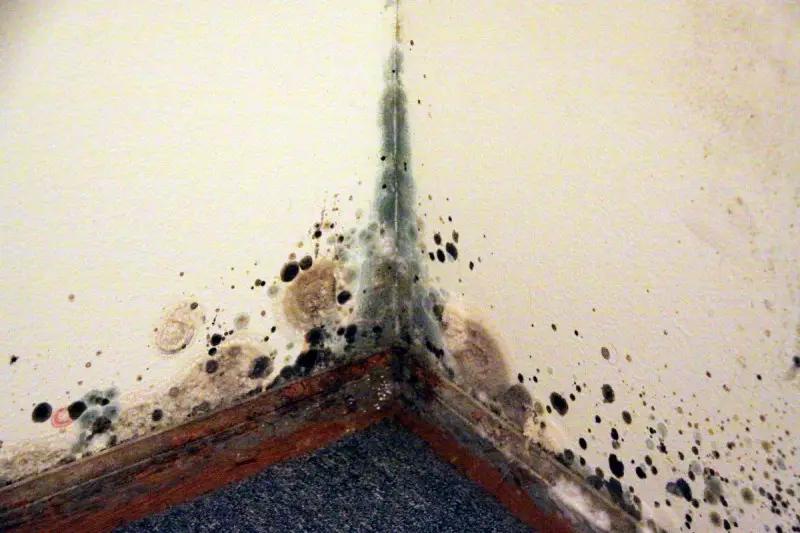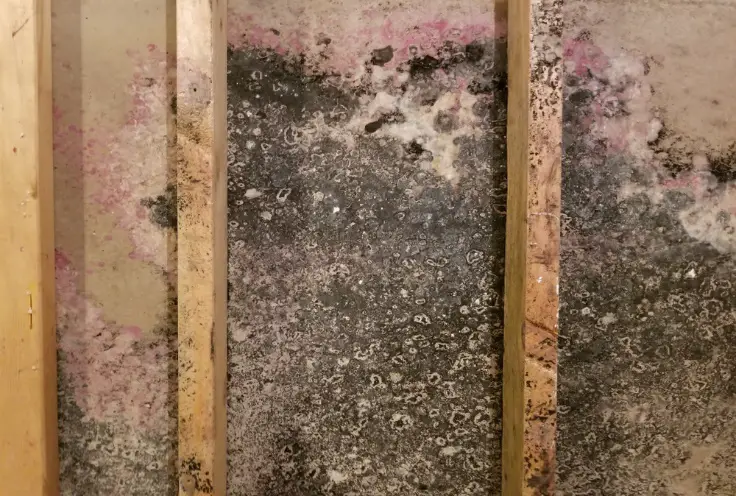
Mold can be a serious issue, especially if it is growing in your home but should you remove drywall with mold? Get insights and practical advice in our guide.
Facing the pressing question of should you remove drywall with mold? It’s one of those home challenges that many of us encounter, but aren’t always sure how to address.
Let’s roll up our sleeves and dive into the nitty-gritty, guiding you every step of the way.
Should You Remove Drywall With Mold?
Here’s why to remove moldy drywall: Mold penetrates beyond the visible surface, compromising the integrity of the drywall. Leaving it untreated can result in structural damage and pose health risks due to mold spore inhalation. Removing and replacing affected drywall ensures a safer, mold-free environment.
Mold can be a serious issue, especially if it is growing in your home but should you remove drywall with mold?
In most cases, it will be necessary to remove drywall that is contaminated with mold.

As you can see from this picture moldy drywall is exposed. A spot of mold on the outside of the wall can look like this on the inside.
You cant treat this with bleach. It should be removed by a professional.
In this blog post, we will discuss the reasons why you should remove moldy drywall and how to tell if your drywall has mold.
We will also provide tips on how to safely remove moldy drywall from your home.
Why To Remove Drywall With Mold
No one likes to find mold in their home. Not only is it unsightly, but it can also cause health problems, particularly for people with allergies or asthma.
If you find mold on your drywall, you may be wondering if you should remove it.
You hate the idea of tearing up your walls and that’s understandable.
The answer depends on the extent of the mold growth. For very small areas of mold, you may be able to clean it with a bleach solution.
But unfortunately, you are only seeing a small part of the mold on the surface.
The mycelium or roots of the mold is much larger than the mold spots you see. It spreads throughout the drywall.
Bleach will remove the spot but it can not penetrate far enough to kill the roots.
So it is usually best to remove the affected drywall and replace it. This may seem like a lot of work, but it is important to get rid of all the mold to prevent it from coming back.
In addition, you should make sure to fix the underlying problem that caused the mold growth in the first place, such as a leaky pipe or excessive humidity.
By taking these steps, you can rid your home of mold and help keep your family healthy.
Do You Have To Replace Moldy Drywall?
At first glance, moldy drywall may not seem like a big deal. However, if left unaddressed, mold can cause serious damage to your home.
Not only can it weaken the structural integrity of your walls, but it can also lead to respiratory problems and other health issues.
In addition, mold is difficult to remove and can spread quickly to other areas of your home.
If you suspect that you have mold in your home, it is important to take action immediately.
The best way to remove mold is to hire a professional who has the experience and training necessary to safely and effectively remove it.
While the cost of hiring a professional may seem high, it is a small price to pay to protect your home and your health.
More info at Black Mold In Homes
What Is Black Mold?
Black mold is a type of fungi called Stachybotrys chartarum that thrives in damp, humid environments.
All it needs is a bit of warmth and some food to grow. It feeds on cellulose like paper, wood, lint, or dust.
Being microscopic it doesn’t take a lot as a food source but drywall is covered with paper so it is a favorite food source for mold.
So if you have mold growing on your drywall, it’s important to remove it as soon as possible.
Not only is mold unsightly, but it can also cause serious health problems.
Inhaling mold spores can trigger allergies and respiratory problems but mold can also cause damage to your drywall.
The longer it is left unchecked, the more damage it will do. If you suspect that you have mold growing on your drywall, don’t hesitate to call a professional for help.
How To Tell If Your Drywall Has Mold
If you suspect that your drywall has mold, there are a few telltale signs to look for.
First, check for any visible discoloration or staining. Mold often appears as black or green spots, so this is a good indicator that you have a problem.
Another sign of mold is surface dimpling or bulging; this happens when mold grows behind the drywall and causes the paper to separate from the gypsum board.
If your drywall is exhibiting either of these signs, it’s important to act quickly.
Since mold can cause serious health problems it’s best to err on the side of caution and have a professional take a look.
In most cases, the affected drywall will need to be removed and replaced.
Tips on How To Safely Remove Moldy Drywall
If you’ve discovered mold on your drywall, you’ll need to take care of it immediately to prevent the spread of spores.
The first step is to identify the source of the moisture that’s causing the mold growth.
If you don’t correct the moisture problem the mold will grow back. Once you’ve done that, you can begin to remove the moldy drywall.
A word of caution here. Sometimes mold removal requires treating a larger area than first thought.
The CDC recommends calling a professional for areas 30 feet or more. A sheet of drywall is 32 square feet. More at Mold | CDC
Larger areas need to be isolated from the rest of the house so spores are not spread throughout the home.
Most homeowners won’t be able to do this so it is best to call in a professional.
Take Safety Precautions
If you decide you can handle the job it is important to take proper safety precautions before starting.
It’s important to wear gloves and a dust mask while you’re working around mold and to avoid creating any dust.
The best way to remove moldy drywall is to cut it out in large sections using a utility knife.
Once you’ve removed all of the affected drywall, you should put it in plastic bags and remove it from your home.
You can treat the area with a fungicide before patching it with new drywall.
By following these steps, you can safely and effectively remove mold from your home.
How to tell if your drywall has mold
If you have noticed any of the following signs, it is time to check your walls for mold:
- Discoloration or stains on walls or ceilings
- Peeling paint or wallpaper
- Cracks in plaster or other wall materials
These are a few signs that you can look for to see if your drywall has mold.
First, take a close look at the surface of the drywall. If you see any discoloration or spotting, this could be a sign of mold growth.
In addition, if the drywall is bowed or warped, this could also indicate the presence of mold.
Finally, if you have any respiratory symptoms such as coughing or sneezing when you are near the drywall, this could be a sign that mold is present.
If you suspect that your drywall has mold, it is important to have it inspected by a professional as soon as possible.
Mold can easily grow on drywall, especially if the drywall is located in an area with high humidity levels.
Prevention tips for keeping mold from returning
Many people have had to deal with mold at some point in their lives. Whether it’s a small patch in the corner of the bathroom or a full-blown infestation, getting rid of mold can be a challenge.
Even after you’ve managed to get rid of it, there’s always the risk of it coming back.
Here are some things you can do to help prevent mold from returning
• First, make sure to keep your home clean and free of clutter. Mold thrives in dark, moist environments, so it’s important to keep things as dry and well-ventilated as possible.
• Another key step is to fix any leaks or other sources of water damage right away. If water is allowed to sit on surfaces for too long, it creates the perfect conditions for mold to take hold.
• Finally, be sure to monitor areas that are prone to mold growth, such as the bathroom and kitchen. By taking these simple steps, you can help keep your home mold-free.
Removing Drywall With Mold? FAQ
If you’ve ever had a sneaky suspicion about mysterious patches on your wall or that odd smell lingering around, you might just be onto something. Mold’s a sneaky critter that loves to set up shop behind our walls.
Got questions about it? You’re not alone! Dive into our FAQ section below, where we tackle some of the most burning questions about mold and drywall. Ready to become a mold-fighting superhero? Let’s go!
Q: Do you have to remove drywall to get rid of mold?
A: In most cases, yes. If mold has infiltrated your drywall, it’s usually best to remove and replace the affected areas. Mold often grows beyond the surface, and while you might kill the surface mold, its roots can still thrive inside.
Q: Is it OK to have mold behind drywall?
A: Definitely not! Mold behind drywall can continue to grow and spread, potentially harming the structural integrity of the wall and causing health problems for those in the home.
Q: How long does it take for mold to destroy drywall?
A: The time mold takes to destroy drywall can vary based on factors like the type of mold and the level of humidity, but mold can start causing damage in as little as 24 to 48 hours under ideal conditions.
Q: What to do if you find mold in drywall?
A: First, identify and rectify the moisture source causing the mold. Then, for larger infestations or if the mold is of a harmful variety, it’s recommended to hire professionals.
If it’s a small patch, you might be able to handle it yourself by cutting out the affected drywall, but always wear protective gear and be cautious not to spread the spores.
Remember to replace the drywall and paint with mold-resistant products if possible.
Should You Remove Drywall With Mold? Final Thoughts
In summing up the pressing matter of moldy drywall, two central points come to the forefront.
Firstly, the integrity of your home’s structure is at stake. Mold not only discolors the surface, but its infiltration weakens the core of the drywall, risking long-term damage and costly repairs.
Secondly, the health implications are undeniable. Persistent mold exposure can lead to respiratory issues and allergic reactions.
Addressing mold promptly not only ensures a sturdy home but a healthier living environment.
If you suspect that there is mold growing on the drywall in your home, it is important to take action immediately.
By taking some simple preventative measures to control moisture you can also help keep mold from coming back.
With a little effort, you can keep your home clean, safe, and mold-free.
